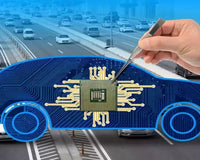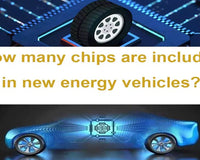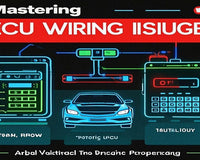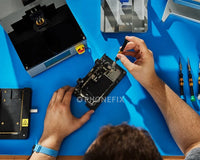With the continuous development of the automobile industry, today's cars are gradually shifting from mechanical to electronic. Cars are becoming more and more intelligent. New energy vehicles are revolutionizing the automotive industry, and at the heart of their advanced technology are various crucial chips, variety of semiconductor chips play crucial roles in different systems, enhancing performance, efficiency, and safety. 
The roles of semiconductor chips in new energy vehicles are becoming increasingly sophisticated as the industry transitions towards higher performance and efficiency standards. A variety of chips play a key role in everything from the tire pressure monitoring system TMPS and cameras to the vehicle controller and autonomous driving domain controller.
1. Power Semiconductor Chips.
Power semiconductors are essential for converting electric power in various applications within NEVs. This includes managing power distribution from the battery to the electric motor and other components.
2. Microcontrollers (MCUs) Chips.
Microcontrollers are part of the vehicle's control systems, overseeing various functions like battery management, motor control, and thermal management. They gather data from sensors and coordinate the operation of the vehicle.
3. Sensors Chips.
Sensor chips are used for a wide range of applications. For example, temperature sensor chips monitor the temperature of the battery, motor, and other components to prevent overheating. Pressure sensor chips are used in tire pressure monitoring systems and to measure hydraulic pressure in braking systems. These sensors provide real - time data to the vehicle's control units, enabling precise control and ensuring the vehicle's safety and reliability.
4. Signal Processing Chips.
These chips manage and process data from multiple sensors in real time. They're integral for systems like advanced driver assistance systems (ADAS), contributing to safety and navigation features.
5. Communication Chips.
Communication semiconductors facilitate vehicle-to-vehicle (V2V) and vehicle-to-infrastructure (V2I) communication, vital for emerging autonomous driving technologies. This includes chips that support connectivity standards like V2X communication.
6. Storage Chips.
Non-volatile memory chips store critical software and firmware that control vehicle operations, including electric drive control and battery management systems.
7. Advanced Driver Assistance Systems (ADAS) Chips.
These specialized chips process complex algorithms needed for functionality such as lane-keeping, automatic emergency braking, and adaptive cruise control. They analyze data from various inputs like cameras and radar to enhance vehicle safety and functionality.
The integration of these semiconductor chips is vital for the functionality, efficiency, and safety of new energy vehicles. With the continuous advancement of technology, more innovative and efficient chips will gradually be born. If you are looking for a variety of chips, you can visit the Chinese ecufixtool store, which has almost launched all the chip models on the market and is constantly updating.
New Energy Vehicle Key Chips: The Backbone of Modern Mobility










